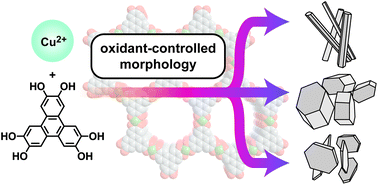Oxidative control over the morphology of Cu3(HHTP)2, a 2D conductive metal–organic framework†
Abstract
The morphology of electrically conductive metal–organic frameworks strongly impacts their performance in applications such as energy storage and electrochemical sensing. However, identifying the appropriate conditions needed to achieve a specific nanocrystal size and shape can be a time-consuming, empirical process. Here we show how partial ligand oxidation dictates the morphology of Cu3(HHTP)2 (HHTP = 2,3,6,7,10,11-hexahydroxytriphenylene), a prototypical 2D conductive metal–organic framework. Using organic quinones as the chemical oxidant, we demonstrate that partial oxidation of the ligand prior to metal binding alters the nanocrystal aspect ratio by over 60-fold. Systematically varying the extent of initial ligand oxidation leads to distinct rod, block, and flake-like morphologies. These results represent an important advance in the rational control of Cu3(HHTP)2 morphology and motivate future studies into how ligand oxidation impacts the nucleation and growth of 2D conductive metal–organic frameworks.

- This article is part of the themed collection: Most popular 2022 materials and energy articles


 Please wait while we load your content...
Please wait while we load your content...